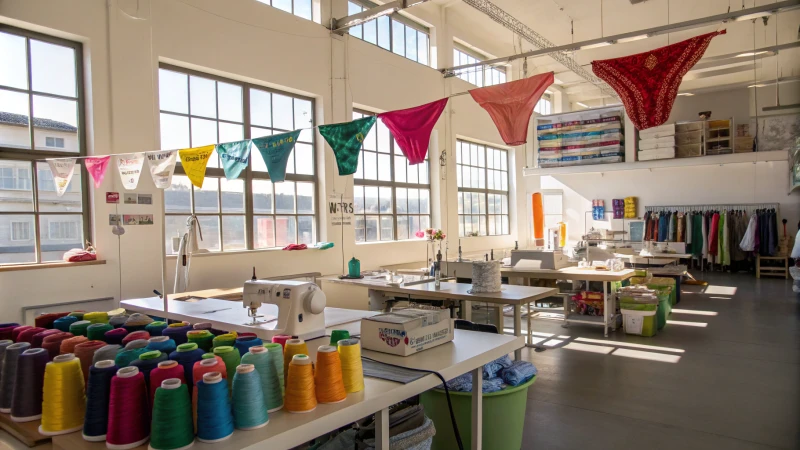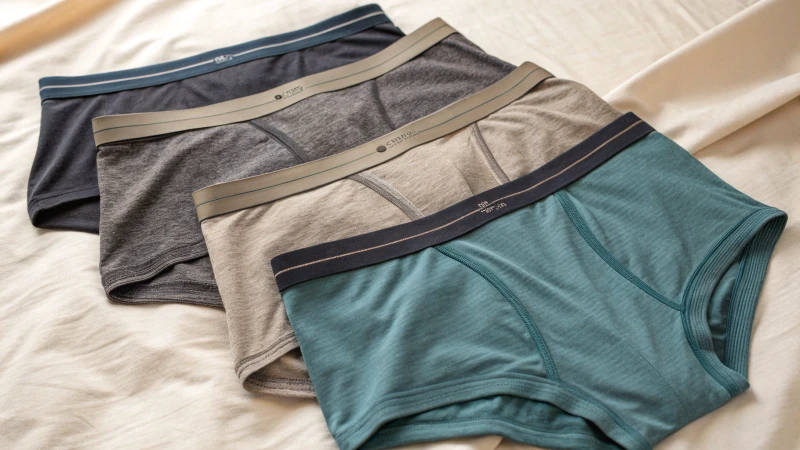
Ever dreamt of growing your custom underwear brand without breaking the bank?
Consignment manufacturing lets me pay for my products only after they sell, easing the financial burden upfront. This model gives me the freedom to test new styles and boosts my cash flow, all while scaling production to meet demand.
While consignment manufacturing initially seems like just a way to dodge hefty upfront costs, it's actually a game-changer. I remember when I first dipped my toes into testing new styles with minimal risk—it was liberating! Instead of drowning in unsold inventory, I could focus on creativity and cash flow, knowing that production could scale with demand. This model has truly been a lifeline for my small brand, allowing me to keep pace with market trends without the constant financial pressure.
Consignment manufacturing reduces upfront investment costs.True
Consignment allows payment after sales, lowering initial financial outlay.
Consignment manufacturing limits style testing flexibility.False
It enhances flexibility by allowing brands to test styles with minimal risk.
How Does Consignment Manufacturing Work?
Imagine running your business without the stress of upfront inventory costs and still having room to experiment with new products.
Consignment manufacturing lets a retailer hold and sell products without buying them upfront. You only pay the supplier for items that sell, while unsold stock can be returned, reducing financial risks and improving cash flow.

The Mechanics of Consignment Manufacturing
Picture this: You're launching a new clothing line, and the idea of fronting thousands on inventory makes you break into a cold sweat. That's where consignment manufacturing comes to the rescue. Here’s how it works: the manufacturer creates goods1 based on what you need. These goods are then sent your way, but here's the kicker—you don't have to pay for them right away. You keep the inventory, and only hand over cash for what sells. Unsold items? They go back to the manufacturer.
Key Benefits for Small Businesses
- Reduced Upfront Costs: I remember when I first started my small business and every penny counted. With consignment, I didn’t have to buy big batches right away, which saved my wallet from feeling too light.
- Flexibility in Inventory: Ever wanted to try out a wild new product idea without betting the farm? This model lets you experiment with less risk.
- Improved Cash Flow: Payments match sales instead of upfront costs, meaning your funds aren't tied up in unsold stock.
| Benefit | Description |
|---|---|
| Reduced Upfront Costs | Minimized financial risk by not buying large quantities initially. |
| Flexibility in Inventory | Test new styles or collections with lower financial commitment. |
| Improved Cash Flow | Payments align with sales rather than upfront purchases, enhancing liquidity. |
Challenges and Considerations
While consignment manufacturing can feel like a dream come true, it does come with its own set of challenges. For instance, think about the logistics of storing inventory and managing returns. Plus, it's crucial to build trust with suppliers since they're footing the bill initially. Understanding these dynamics2 is key to making consignment work seamlessly.
Real-World Applications
Consignment isn't just a buzzword—it’s a strategy used across industries from fashion to electronics. Take small custom underwear brands, for example; they use this model to test out styles without the pressure of high-volume commitments. Exploring case studies3 can offer deeper insights into how different businesses leverage consignment manufacturing successfully.
Consignment manufacturing requires upfront payment by retailers.False
Retailers pay only for sold items, not upfront.
Consignment manufacturing can improve cash flow for businesses.True
Payment aligns with sales, avoiding unsold inventory costs.
Why Is Consignment Ideal for Testing New Styles?
I remember the first time I dipped my toes into the fashion world, feeling both thrilled and terrified at the thought of introducing new styles.
Consignment is perfect for testing new styles because it lets designers launch collections without upfront costs, reduces financial risks, and adapts to consumer demand with flexible production terms.

The Financial Flexibility of Consignment
Starting out in fashion felt like standing at the edge of a cliff. The initial costs alone could make anyone hesitate. But consignment? It was like someone handed me a parachute. Rather than buying inventory outright and hoping it sells, I only had to pay once the items were actually purchased by customers. This approach transformed those scary upfront costs into manageable ones, easing financial risk4 and making it a viable option for smaller brands like mine.
Adapting to Consumer Preferences
In my experience, nothing beats seeing firsthand what customers actually want. With consignment, I could test out styles and get immediate feedback based on what flew off the shelves and what gathered dust. It was like having a direct line to my consumers' hearts, allowing me to tweak and refine my products without the weight of a massive inventory hanging over my head. Consumer feedback5 became an invaluable tool in this process.
Reducing Minimum Order Quantities (MOQs)
High MOQs were always a roadblock for me, a small player in a big industry. But consignment offered a way around this hurdle. With more lenient MOQs, I could produce just what was needed—no more, no less. This flexibility meant less wastage and more room for experimentation. I could try out that daring new style without committing to hundreds of units upfront.
| Benefits of Consignment | Traditional Manufacturing |
|---|---|
| Payment after sales | Upfront payment |
| Flexible MOQ | High MOQ |
| Adaptable to demand | Rigid production schedules |
Real-World Applications
Take the custom underwear market, for instance—a perfect playground for consignment's benefits. I've seen brands in this niche thrive by rolling out edgy designs with minimal financial exposure. By aligning payment with sales and tailoring production to actual demand, they kept cash flow smooth and avoided the dreaded overstock issues6. Consignment's flexibility has been key in helping various fashion sectors stay competitive and aligned with market needs.
Consignment reduces upfront costs for new fashion styles.True
Designers pay only after items are sold, minimizing initial expenses.
Traditional manufacturing offers more flexibility than consignment.False
Consignment provides flexible MOQs and adapts to demand, unlike traditional methods.
How Can Consignment Improve Your Cash Flow?
Imagine running a store without the stress of upfront costs. That's the magic of consignment.
Consignment boosts cash flow by letting businesses delay payment until items sell, cutting initial costs and financial risks. It aligns expenses with sales, enhancing liquidity and flexibility.

Understanding Consignment and Its Financial Impact
When I first started my own little retail venture, I stumbled upon the concept of consignment, and it was a game-changer. With consignment, I could stock shelves without breaking the bank right away. I only paid my suppliers after a sale was made. This meant my expenses were aligned with actual revenue, which made a huge difference in how I managed my cash flow. Cash flow management7 suddenly became less of a headache and more of a strategic advantage.
Take, for example, a friend of mine who runs a small apparel store. She decided to bring in a fresh line of clothing on consignment. This move allowed her to delay payments until the clothes flew off the racks, easing the initial financial crunch. As a result, she could channel her funds into marketing or improving store operations, giving her business a much-needed boost.
Key Advantages of Consignment for Cash Flow
| Benefit | Description |
|---|---|
| Reduced Upfront Costs | Pay for inventory only after sales, freeing up capital for other investments. |
| Improved Liquidity | Ties costs directly to sales, providing a predictable cash outflow pattern. |
| Lower Financial Risk | Limits the financial risk associated with unsold inventory. |
| Scalability | Adjusts easily with demand fluctuations without significant financial strain. |
Exploring Real-World Applications
I remember meeting a custom furniture maker at a local trade show who shared his story about using consignment. By showcasing his creations in multiple stores without upfront costs, he could gauge market interest before committing to full-scale production. This flexibility meant he wasn't burdened with unsold inventory piling up in his workshop. Consignment allowed him to breathe easier financially while supporting sustainable growth.
Moreover, many retailers I know appreciate the lenient MOQs8 that come with consignment deals. These arrangements let them quickly adapt to changing consumer trends without overextending their resources.
Comparing Consignment with Traditional Inventory Models
When comparing consignment with traditional models, the distinctions become apparent:
| Aspect | Consignment | Traditional Model |
|---|---|---|
| Payment Timing | After sale | Before stocking |
| Risk Level | Lower (due to delayed payment) | Higher (due to upfront investment) |
| Cash Flow Impact | Positive (aligns payments with income) | Potentially negative (tied-up capital) |
Overall, understanding these strategic benefits has not only helped me optimize my cash flow but also minimize financial risks. Embracing consignment has paved the way for growth, allowing me to stay competitive in an ever-changing market.
Consignment reduces upfront inventory costs.True
Consignment allows payment after sales, freeing capital for other uses.
Consignment increases financial risk for retailers.False
It lowers risk by aligning costs with sales and reducing unsold stock issues.
How Can Consignment Help Scale Production Efficiently?
Imagine being able to scale your business without the financial strain of unsold inventory piling up. Consignment might just be the secret ingredient to efficiently scale production.
Consignment helps businesses scale by lowering upfront costs and syncing inventory with demand. This model reduces financial risks by paying only for sold items, boosting cash flow and allowing flexible scaling.

Understanding the Consignment Model
Picture this: I once walked into a store as a small-time underwear brand owner, feeling the weight of unsold inventory like a chain around my ankle. Consignment changed everything. This model lets suppliers place their products with retailers, who only pay when items sell. It's a game-changer for retailers because it slashes initial costs and financial risks.
Benefits of Consignment
Reduced Financial Risk
- I remember the relief of not having to worry about unsold stock. You pay only for what gets sold, keeping unsold items off your books.
- This is a lifesaver for startups or small businesses, like mine, where cash flow can be tight.
Flexible Scaling
- Consignment lets you dip your toes into new products or markets without jumping in headfirst. I tested a new line of bold prints without a huge commitment.
- The more lenient minimum order quantities9 allowed me to align production with actual demand.
Improved Cash Flow
- With sales driving payments, I didn’t have cash tied up in unsold inventory, freeing me to invest in marketing and development.
- The result? A healthier bottom line and more opportunities for growth.
Practical Application of Consignment
Here's how different industries benefit:
| Industry | Benefit | Example Scenario |
|---|---|---|
| Fashion | Reduced inventory risk | Testing new clothing lines in various stores |
| Electronics | Quick adaptation to trends | Launching gadgets without overproducing |
| Food & Beverage | Minimized spoilage | Offering seasonal products with unpredictable demand |
Tracking and Management Tools
Effective consignment isn’t just set-it-and-forget-it; it requires solid tracking systems. I learned the hard way how essential inventory management software is in keeping operations smooth. Advanced solutions10 automate reconciling sold goods, cutting down on admin work.
By integrating these tools, businesses like mine can keep the supply-demand balance just right, boosting efficiency in scaling.
Consignment reduces retailer's upfront costs.True
Retailers pay only for products sold, lowering initial expenses.
Consignment requires retailers to prepay for inventory.False
Retailers pay after sales, not before, reducing financial risk.
Conclusion
Consignment manufacturing benefits small custom underwear brands by reducing upfront costs, improving cash flow, and allowing flexible testing of new styles without financial risk.
This link explains the step-by-step process of consignment manufacturing, providing clarity on how it operates from start to finish. ↩
Discover the common logistical hurdles faced in consignment manufacturing and how businesses can effectively overcome them. ↩
Explore real-world examples of businesses thriving with consignment manufacturing models across various industries. ↩
Learn how consignment reduces initial investment risks, essential for launching new styles without significant financial commitments. ↩
Discover strategies for leveraging consumer feedback to refine fashion products effectively. ↩
Explore how consignment helps in maintaining efficient inventory management with reduced wastage. ↩
Explore this link to gain deeper insights into how consignment models enhance cash flow management through strategic payment alignment. ↩
Discover how lenient minimum order quantities in consignment agreements can benefit small businesses by reducing financial commitments. ↩
Understanding minimum order quantities helps businesses negotiate better terms and manage inventory efficiently. ↩
Discovering top inventory management solutions enhances operational efficiency and tracking accuracy. ↩






